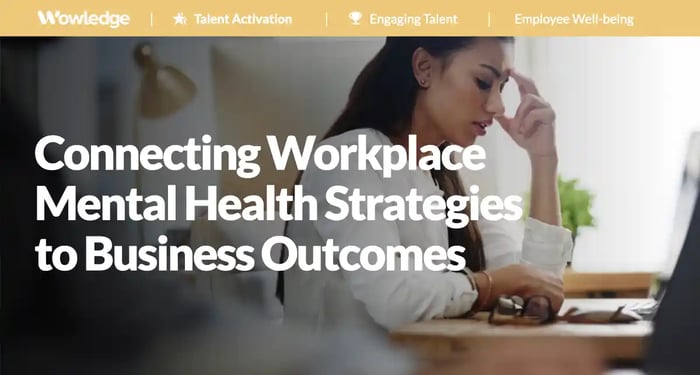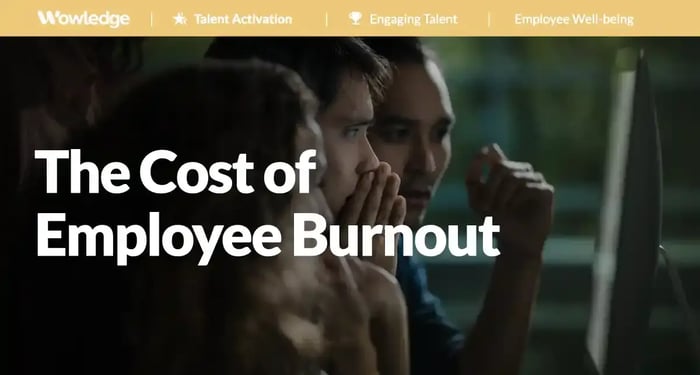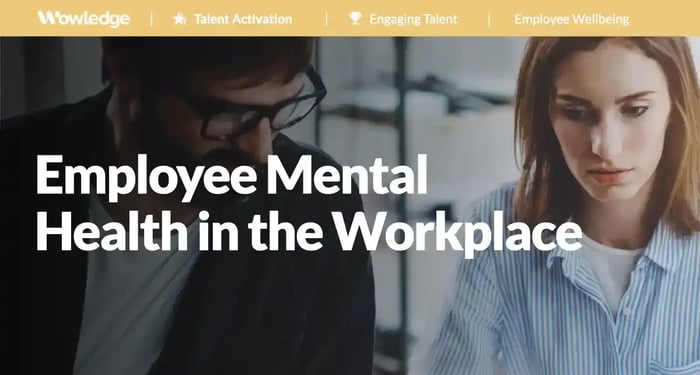Table of Contents
- Compelling reasons for improving employee well-being
- 1. Increase employee productivity
- 2. Reduce turnover
- 3. Enable change adoption
- 4. Generate organizational agility
- 5. Create hybrid collaboration
- 6. Enhance staffing and employer brand
- 7. Decrease risk exposure
- 8. Strengthen engagement
- 9. Improve inclusion and belonging
- 10. Establish effective operational execution
- 11. Lower health costs
- In closing
- Relevant Practices & Tools
- FAQs
As we continue exploring this new world of work, one area that has changed is the attitude and attention to workplace mental health, and how to link it to business outcomes. This change is accelerating as the next generation hits the workforce. “Members of Generation Z—the oldest of whom are 25—prioritize mental wellness. Report after report shows they expect tangible employer support and to be comfortable talking about their struggles without feeling stigmatized,” says a recent SHRM article. Mental health is no longer something an individual handles in private; the growing understanding is that our workplaces have an extensive impact on employees’ psychological well-being.
This shift is supported by solid research insights that connect workplace mental health strategies with business outcomes over the last few decades. Through peer-reviewed studies, we now understand that there is, in the words of the U.S. Surgeon General’s framework for Workplace Mental Health and Wellbeing, “a reckoning among many workers who no longer feel that sacrificing their health, family, and communities for work is an acceptable trade-off. Organizations are also increasingly aware of another trade-off: when the mental health of workers suffers, so does workplace productivity, creativity, and retention.”
Despite these insights, a disconnect between the C-suite and the broader employee experience continues. A recent Deloitte review of the situation identified how executives “significantly underestimate how much employees struggle with their emotional well-being.” Indeed, that research demonstrated that executives believe employee mental health is 42% higher than reality. Furthermore, a belief in the importance of workplace mental health is not translating into investment, with 68% of companies seen as not taking enough action.
One way to address this inaction is to emphasize the connection between worker mental health and business outcomes. Aligning workplace mental health initiatives with business outcomes underscores the inherent interconnectedness between employee well-being and organizational success. By demonstrating how investments in mental health positively impact key business metrics such as productivity, employee retention, and change adoption, advocates can garner more significant support and resources for mental health programs. Furthermore, this alignment fosters a culture where mental health is considered integral to business sustainability, encouraging proactive measures to create psychologically healthy workplaces that benefit employees and the bottom line.

Compelling reasons for improving employee well-being
While not an exhaustive list, the following are critical business outcomes scientifically demonstrated to significantly improve the health and safety of organizations. Not all of these may be pertinent to your business, but by selecting the ones that are, one can better build a business case for investment. Furthermore, one can target efforts to measure the impact on the business, demonstrating value and broadening support.
1. Increase employee productivity
Employees who are not as productive as the business needs can strain the entire system and negatively impact co-workers and customers. Low productivity has a significant ripple effect, including missing deadlines and deliverables.
Diagnosing the Problem:
- Missed deadlines
- Unclear priorities
- Imagined emergencies
- Busy with no outcomes
- Inconsistency
Why Mental Health Matters: Psychologically healthy workplaces have shown a 30% improvement in employee productivity (Anjum 2018). Furthermore, healthy workers identify barriers and can better resolve conflicts that may hold them back.
2. Reduce turnover
Many organizations are experiencing higher-than-desired turnover rates, particularly in industries with tight labor markets. Employees can leave to find better working conditions, more flexibility, higher compensation, or leadership more aligned with their values.
Diagnosing the Problem:
- Increased absenteeism
- Delays filling positions
- Under-resourced work
- Negative online reviews
- Disengagement
Why Mental Health Matters: Psychologically healthy workplaces foster an environment where employees feel comfortable expressing their concerns and contributing their ideas without fear of negative consequences, leading to higher job satisfaction and engagement. When employees know their voices are valued and their well-being is prioritized, they are more likely to stay with the company, according to some studies showing a 45% difference in “leave intention” between healthy and unhealthy workplaces.
3. Enable change adoption
The pace and scale of change in today's rapidly evolving business landscape can overwhelm teams. Many organizations struggle with effectively communicating the rationale and benefits of change to employees, leading to resistance and skepticism.
Diagnosing the Problem:
- Apathy or detachment
- Frequent errors or mistakes
- Continued use of old methods
- Undermining new ideas
- Miscommunication & distrust
Why Mental Health Matters: Employees with healthy workplaces are more open to embracing change, as they trust that their well-being is valued. Additionally, a supportive atmosphere fosters effective communication, enabling teams to collaborate, adapt, and implement changes more successfully. One study, for example, demonstrated a 70% increase in change adoption when teams felt psychologically safe.
4. Generate organizational agility
With highly dynamic markets, many businesses have had to make the difficult decision to restructure and eliminate positions. These changes aim to find efficiencies and retain the organization's most critical roles (and talent). However, research shows that nearly 8% of the employees who remain following a layoff will also leave the organization. “Researchers have known for some time that quitting is contagious,” says Rebecca Knight, author of “Layoffs Can Cause Contagion that Pushes Workers who are Left Behind to Quit.” The same is true following the resignation of a peer. A Vizier study of this “turnover contagion” showed that teams with a resigning member were nearly 10% more likely to have other members depart in the next 4.5 months. Moreover, the smaller the team size, the higher the risk, with teams of 10 or fewer having a 17% likelihood of additional departures.
Diagnosing the Problem:
- Disengagement
- Cynicism
- Lack of commitment to long-term deadlines
- Decreased productivity
- Increased absences
- Team size decreases
Why Mental Health Matters: Common responses to layoffs can be anticipated by understanding the psychological impact. Reactions immediately following departures include imposter syndrome, negativity, anger, fear, overwhelm, and grief. When executives know these expected behaviors, they can be planned for and addressed beforehand.
5. Create hybrid collaboration
The rapid transition to remote work has altered traditional collaboration approaches and required organizations to adjust. This change has created discomfort with some and been embraced by others. Given the importance of team collaboration, addressing gaps in this area is critical to business performance.
Diagnosing the Problem:
- Distrust
- Miscommunication
- Lack of connection
- Excessive work monitoring
- Declines in quality
Why Mental Health Matters: A healthy workplace fosters trust and open communication, which is essential for remote collaboration. When employees feel psychologically safe and supported, they are more likely to share ideas, ask questions, and express concerns, leading to improved collaboration. According to some studies, this can lead to over 400% improvement in innovation.
6. Enhance staffing and employer brand
The shortage in talent has hit record numbers in recent years, with research showing that as many as 78% of businesses are currently understaffed. Finding and retaining employees, particularly those at the frontline, is critical to business performance. Without proper staff, the opportunity to service customers decreases, as does the burnout of remaining employees.
Diagnosing the Problem:
- Unfilled positions
- Overtime pay
- Longer customer service/wait times
- Decrease in services
- Increase in customer complaints
Why Mental Health Matters: Beyond the psychological strain of working in understaffed environments, one key to attracting talent is a clear commitment and support strategy for workers' mental health. According to the American Psychological Association, 81% of workers find mental health support an essential part of their decision to work with an employer.
7. Decrease risk exposure
When employees experience high levels of stress, burnout, or anxiety due to inadequate support or a toxic work environment, it can lead to reputational damage, legal liabilities, and decreased employee morale, undermining an organization's long-term success and competitiveness. One survey showed that 87% of leaders believe the health and safety of their workforce is a serious threat to their business.
Diagnosing the Problem:
- High error rates
- Low accountability
- Customer complaints
- Increased injuries
- Low error identification
Why Mental Health Matters: A psychologically safe work environment mitigates the risks of poor communication, low morale, and diminished productivity. Furthermore, it enhances the organization's reputation, reducing the risk of damage to its brand and attractiveness to top talent.
8. Strengthen engagement
Employees who experience low psychological safety most frequently have lower engagement rates. Disengaged employees often exhibit lower productivity and reduced commitment to their roles and the organization. This lack of engagement can lead to higher turnover rates, increased absenteeism, and diminished overall team morale, ultimately affecting the company's performance and profitability.
Diagnosing the Problem:
- Low initiative
- Negativity bias
- Decreased productivity
- Higher turnover intentions
- Team conflict
- Decline in customer satisfaction
Why Mental Health Matters: A recent study shows that psychological safety increases engagement by 43%. When employees perceive that their psychological safety is prioritized, they are more likely to be engaged, as they feel secure in sharing their ideas, taking calculated risks, and collaborating openly. This positive engagement, in turn, fosters a culture of innovation, productivity, and loyalty within the organization.
9. Improve inclusion and belonging
The lack of inclusivity can reduce employee morale, engagement, and retention and hinder innovation and creativity. Failing to address these issues can ultimately harm a company's reputation, hinder its ability to attract top talent, and limit its potential for long-term success in a diverse and competitive global marketplace.
Diagnosing the Problem:
- Microaggressions
- Exclusionary behaviors
- Ignoring or interrupting
- Unequal opportunities
- Exclusive social circles
Why Mental Health Matters: Psychological health and safety in the workplace foster an environment where employees feel respected and valued for their unique perspectives and experiences, with some studies showing an improvement of over 50%. This inclusivity helps create a sense of belonging among team members, who perceive themselves as integral parts of a diverse and supportive community.
10. Establish effective operational execution
Poor operational and business outcomes are significant concerns because they directly impact revenue, profitability, and competitiveness. When employees fail to execute tasks effectively or identify obstacles to execution, it can harm a company's bottom line and reputation.
Diagnosing the Problem:
- Unidentified errors
- Employee silence
- Conflict avoidance
- Fixed mindsets
- Punishment for speaking up
Why Mental Health Matters: Safe and healthy organizations enable execution by providing role clarity, autonomy, accountability, and the courage to share ideas and identify issues. Studies show that as few as 1% of most employee populations will speak up when they see something wrong. When psychological safety improves, however, critical actions, like error identification, increase ten times (10X).
11. Lower health costs
High health costs, such as rising insurance premiums and healthcare expenses, can strain an organization's budget, reducing resources for other critical investments or employee compensation. Health-related issues, including absenteeism and reduced productivity due to illness, can directly affect performance.
Diagnosing the Problem:
- Rising costs
- Increased injuries
- Missed work
- Incident-related absences
Why Mental Health Matters: Direct costs due to stressed employees have increased substantially in recent years, with an overall rise of 53% since 2020. Additionally, stress and unhealthy workplaces have a broader impact on employee wellness, increasing the risk of illness and on-the-job injury. Proactively addressing these hazards helps organizations mitigate potential costs.
In closing
The impact of understanding the connection between workplace mental health and business outcomes cannot be overstated. Organizations will quickly face new and changing demands as a new generation of work evolves. This change is coming quickly, with the Gen Z population expected to account for 27% of the workforce within the next 14 months. Given the context these new team members grew up in, we are seeing an overwhelming number of them grappling with mental health, with some research showing this as high as 42% of the Gen Z population. The good news is that investing in a proactive workplace mental health strategy has many well-documented business advantages besides those listed above. These are beneficial to all members of your workforce. HR leaders should equip themselves with this data to help drive this much-needed change in modern workplaces, resulting in better performance and more humane and thriving cultures.
Relevant Practices & Tools
Core Workplace Wellness Practices for Building the Fundamentals of Total Worker Health. >
Workplace wellness has become a fundamental expectation of workers and only continues to grow as new pressures are put on the workforce... more »
Defining a Comprehensive Strategy for Total Worker Health Across All Aspects of Employee Well-being. >
As one saying goes, “We hired employees, but people came to work.” In other words, team members are not just a contribution of skills; they bring complexity and nuance to the workforce... more »
Conducting a Formal Wellness Assessment to Identify Critical Priorities for Driving Employee Well-being and Talent Outcomes. >
As the environment for wellness is more clearly understood, it is necessary to identify programs and offerings that will help protect worker health and support those who become ill or injured... more »
Engaging Employees to Co-create Wellness Solutions that Increase Engagement and Promote Enduring Practices. >
Traditionally, the decision of what wellness programs to offer employees comes from behind the closed doors of the HR function, often sitting with a benefits manager... more »
The Total Worker Health Assessment Tracker: Define Assessment Plans and Analyze Trends to Identify Focus Areas Shaping Wellness Strategy. >
This tool provides a structured approach to capture comprehensive snapshots of employee wellness based on the National Institute for Occupational Safety and Health (NIOSH) Total Worker Health assessment questions... more »
FAQs
How should an organization build a business case that links mental health to hard outcomes?
A credible case starts with a baseline of current-state metrics, such as productivity, absence, turnover, safety incidents, claims costs, and employee listening data, and then quantifies the avoidable costs and value at risk. Interventions should be mapped to specific outcome levers, such as reducing time-to-productivity or increasing error reporting. A partnership with the Finance function is essential for validating assumptions and selecting attribution methods, such as statistical regression analyses. The case should include a 12–24-month ROI horizon, with leading indicators reported monthly, and lagging indicators reported quarterly.
Which metrics best demonstrate whether mental health strategies are working?
A balanced scorecard should pair survey-based indicators (e.g., psychological safety, burnout, engagement, and manager effectiveness) with “hard” operating outcome metrics such as rework rates, cycle time, schedule adherence, and first-contact resolution. Health outcomes such as EAP utilization, absenteeism, short-term disability days, and preventable ER visits provide additional signals. Turnover in pivotal roles and time-to-fill show talent impact. All metrics should be stratified by function, level, and location to identify hotspots and equity gaps.
How can HR gain executive buy-in when leaders view mental health as “soft” or non-core?
Translate the problem into business terms that leaders own, using their KPIs and customer impacts. Share internal benchmark data showing the cost of inaction alongside quick wins from small tests. Present options with cost, risk, and expected return, not generic programs. Secure a senior sponsor who commits to visible role modeling and incorporates mental health targets into leadership objectives.
What manager capabilities most strongly influence mental health outcomes on teams?
The most predictive are clarity setting, empathic listening, workload shaping, and timely risk escalation. Managers also need skills in running psychologically safe meetings and interactions that surface issues, errors, and barriers to well-being. Short, scenario-based practice with feedback outperforms lengthy workshops. Success should be reinforced through coaching, peer cohorts, and performance expectations.










